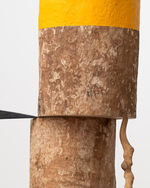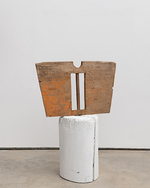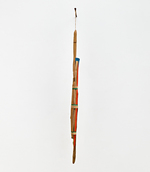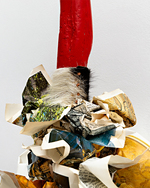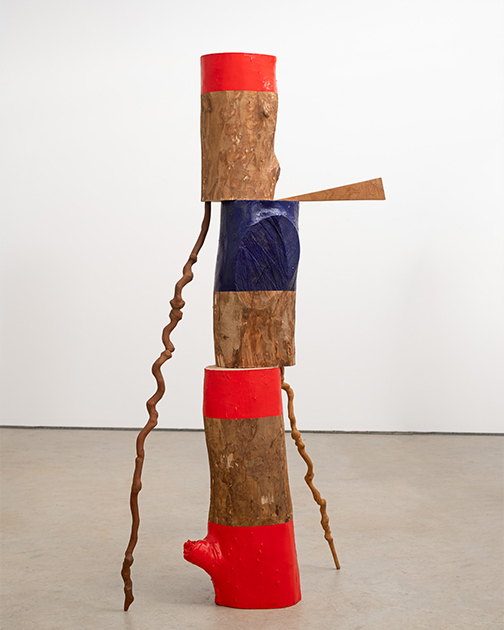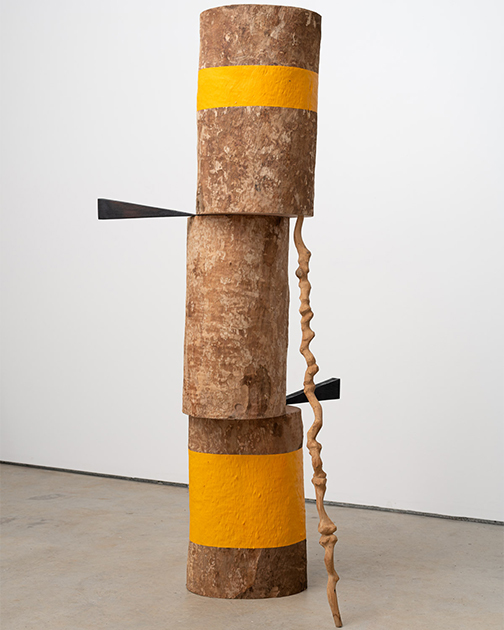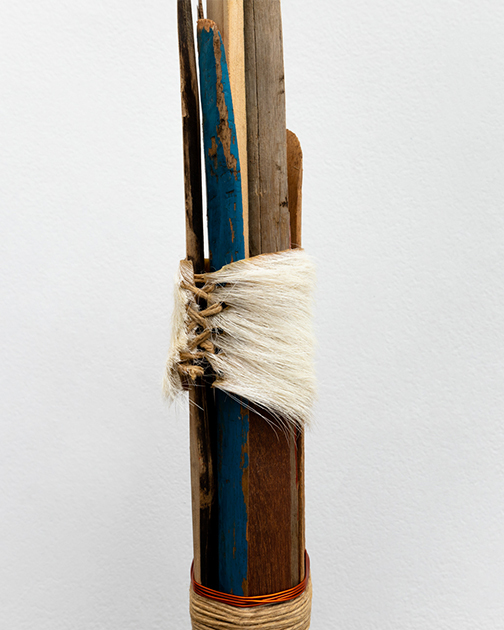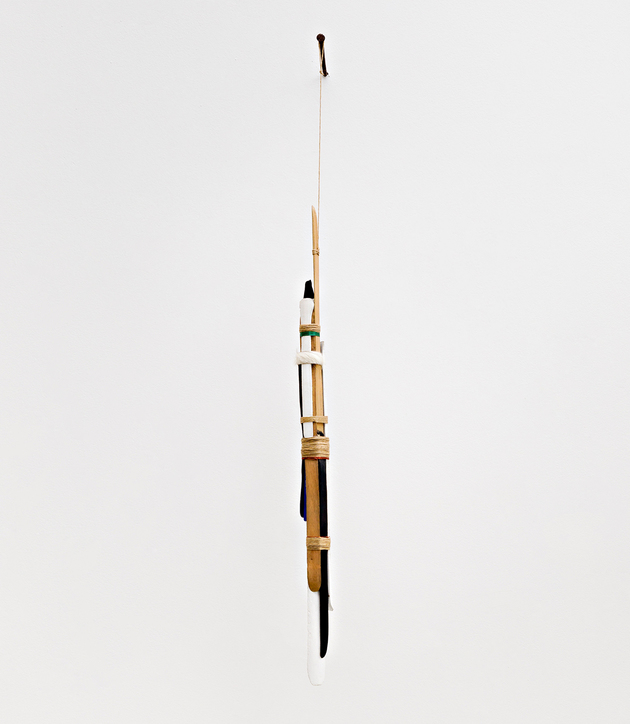Afonso Tostes | Ajuntamentos
Ajuntamentos
Luisa Duarte
Ao longo dos últimos anos, testemunhamos uma profunda revisão histórica feita de um ponto de vista anticolonial que busca compreender as violências epistemológicas constitutivas da história da arte. De um modo muito singular, sem mimetizar maneirismos formais ou discursivos, a exposição “Ajuntamentos”, de Afonso Tostes, ecoa esse movimento de mudança que marca o presente. E por que de um modo singular? Porque, na obra de Tostes, o que se dá não é uma recusa do repertório do cânone ocidental, mas, antes, o encontro entre dois rios. Por um lado, aquele cujas águas formam o conjunto de obras reconhecidas por uma historiografia oficial, por outro, aquele irrigado pelos saberes dos povos tradicionais. Esse é um dos ajuntamentos forjados pelo artista.
*
A instalação que abre a mostra apresenta o equilíbrio entre cordas que perpassam o espaço, pontuadas por uma série de elementos coletados pelo artista em viagens pelo Brasil. O trabalho tem como inspiração a forma de varais vistos em comunidades ribeirinhas, já os seus diversos pontos de apoio trazem índices encontrados por Tostes em suas derivas pelas bordas do país. Nas pontas dessa obra – parte de uma série chamada “Linha do tempo” – pendem ripas de madeira lixadas, que revelam a forma de grandes lápis, associadas a fragmentos de uma antiga enciclopédia ilustrada cujos volumes foram encontrados ao acaso pelo artista nas ruas de Copacabana. A madeira tem como origem restos de uma casa de pau a pique demolida no interior de Minas Gerais, ou seja, traz consigo a memória de uma arquitetura vernacular surgida da mescla de técnicas portuguesas, indígenas e africanas. Assim, as frações da enciclopédia que evocam uma organização do saber característica da racionalidade ocidental estão enlaçadas com aquilo que remete a outro tipo de conhecimento, o gerado de maneira anônima pelos saberes populares.
O jogo de equilíbrio visto no varal se dá, também, nas grandes esculturas em madeira que remetem a formas totêmicas. Aqui, fragmentos de troncos achados no Parque Ibirapuera estão sobrepostos uns sobre os outros em uma estabilidade tênue. Corroboram para mantê-los de pé ripas e peças esculpidas, chamadas pelo artista de “bengalas”, que recordam o desenho de ossos. Uma dimensão pictórica é engendrada pela presença de segmentos cobertos por diferentes cores. Ao nos aproximarmos desses trabalhos, não é difícil lembrar de Constantin Brâncusi e seu gesto seminal, que retirou da escultura o pedestal. Ao mesmo tempo, muito dessas obras é devedor de uma vivência orgânica do artista dentro de universos que estão às margens da chamada cultura erudita.
Na verticalidade de cada uma dessas obras, há uma remissão às arvores que constituem o passado da madeira, assim como tal escala nos convida a uma relação não só retiniana, mas também corpórea. Os modos pelos quais permanecem de pé lembram, por sua vez, as soluções astutas inventadas para escorar lajes ou muros em cidades do Brasil. Já o uso das cores pode rememorar as pinturas feitas por comunidades pesqueiras em suas embarcações com a finalidade de protegê-las das intempéries, mas que findam por alcançar um aguçado registro estético. Note-se que tal dinâmica de associações não deve ser lida como uma espécie de bula a ser seguida no encontro com o trabalho. Tudo na obra de Tostes passa ao largo da literalidade. Tal como a sustentação dessas esculturas, o artista prefere habitar um território fluido, avesso aos juízos totalizantes e mais próximo do que Boaventura de Souza Santos chamou de uma “ecologia dos saberes”.
Todas as obras hoje reunidas foram erigidas a partir de elementos que já estão no mundo. Tal escolha comporta, obviamente, um sentido ético. Em meio a uma época marcada pelo excesso de entes descartáveis, que nascem munidos de uma obsolescência programada, Tostes caminha na contramão de tal jornada predatória. Até mesmo as pequenas telas da série “Reforma” são resultado desse olhar atento para o que já habita as entrelinhas do seu universo mais próximo. Ali, vemos pinturas cuja “tinta” é o pó da madeira que resulta do lixamento das esculturas. O que estava fadado ao descarte, ao esquecimento, aquilo que é microscópico quando isolado, e ganha força enquanto coletividade, foi cuidadosamente reunido ao longo do tempo, guardado, para, por fim, encontrar pouso nas superfícies dessas telas monocromáticas e geométricas. Note, ainda, como as pinturas escalam a parede, umas escoradas nas outras, como que evocando o movimento das esculturas.
*
O mesmo momento histórico que testemunha a virada epistemológica anticolonial sinalizada no começo deste texto é, também, aquele que assiste ao crescimento de ondas reacionárias cujo denominador comum está na ideia de união pelas similaridades e rejeição às alteridades. Tal comunhão por semelhança implica uma busca guiada pelas noções de pureza e exclusão. Ora, os ajuntamentos tecidos por Afonso Tostes ao longo da sua obra nos levam para as antípodas de tal curso regressivo. Estamos diante de um gesto a um só tempo poético e político que nos convoca a imaginar um mundo mais polifônico e solidário – um mundo de muitos mundos.
abertura: 04 de fevereiro, das 14h às 18h
visitação: de 04/02/2023 a 11/03/2023
segunda, das 10h às 18h; terça a sexta, das 10h às 19h; sábado, das 11h às 17h
-
Luciana Brito Galeria
Avenida Nove de Julho 5162
São Paulo Brasil 55 11 3842 0634








